Scientific Equipment
MILTON ENTERPRISES, Nashik 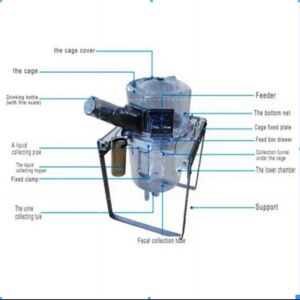 Metabolic cages are specialized enclosures used in scientific research to measure various aspects of metabolism in rats and mice. These cages are designed to allow researchers to monitor factors such as:
Food and water intake: Metabolic cages typically have separate compartments for food and water, allowing precise measurement of consumption over time.
Urine and feces collection: They are equipped with collection devices to gather urine and feces, enabling the measurement of metabolites, hormone levels, and other biochemical markers.
Activity monitoring: Many metabolic cages are equipped with sensors or cameras to track the animal's movement and activity levels, providing insights into energy expenditure and overall metabolic rate.
Respiratory measurements: Some advanced metabolic cages can also measure oxygen consumption and carbon dioxide production, which are important indicators of metabolic activity.
Overall, metabolic cages provide a controlled environment for studying the metabolic processes of rodents under various experimental conditions, helping researchers understand aspects of nutrition, physiology, pharmacology, and disease. MILTON ENTERPRISES, Nashik .png) Isolated Organ Bath An isolated organ bath is an apparatus used to study the function of an isolated organ or tissue sample in a controlled environment. This setup allows for precise control over the experimental conditions, such as temperature, oxygenation, and the addition of drugs.
Components and Function:
Organ Chamber: A glass or plastic bath that holds the isolated tissue or organ. It is filled with a physiological solution that mimics the body's internal environment. Aeration System: Provides oxygen to keep the tissue alive and functional.
Heating System: Maintains the physiological solution at a constant, appropriate temperature.
Force Transducer: Measures the contractions or responses of the tissue and converts them into electrical signals.
Recording System: Captures the data from the force transducer, often interfaced with a computer for analysis.
Uses in Pharmacology:
Drug Response Testing: By adding different drugs to the bath, researchers can study their direct effects on the tissue, such as contractions in smooth muscle or changes in vascular tone.
Mechanistic Studies: Helps in understanding the mechanisms of drug action, receptor activity, and signaling pathways within tissues. Applications Both the kymograph and the isolated organ bath are essential tools in pharmacological research.
They allow scientists to: Investigate the direct effects of drugs on isolated tissues. Analyze the physiological changes induced by pharmacological agents. Understand the underlying mechanisms of drug action and tissue response.MILTON ENTERPRISES, Nashik  A tissue healing tensiometer is used in medical and pharmaceutical research to measure the mechanical properties of healing tissues, such as tensile strength and elasticity. It assesses the progress and quality of tissue repair by applying controlled force and measuring the response of the tissue. This information is crucial for evaluating the effectiveness of treatments, wound healing products, and surgical techniques, ensuring that tissues regain their original strength and functionality post-injury or surgery. MILTON ENTERPRISES, Nashik 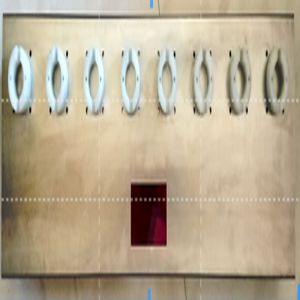 Enterprises Laboratory Manufacturing reinvented diffusion cell apparatus is used to study of trans-dermal properties of pharmaceutical substances in the pharmacy colleges, medical research institutes and pharmaceutical industries. Having 6â??stages & 8-stages, user can drive each stirrer stage at different RPM from 50 RPM to 950 RPM, diffusion cell apparatus provided with water circulation system to maintain uniform temperature throughout all diffusion cells, water circulation system consists of water circulation pump which circulate water to all diffusion cells, and get back to maintain temperature. MILTON ENTERPRISES, Nashik 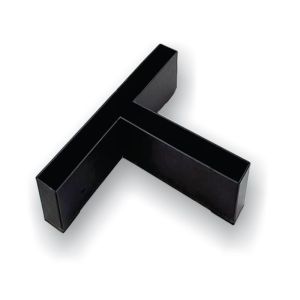 The T-maze is a commonly used behavioral apparatus in research with rodents, typically rats and mice, to study learning, memory, decision-making, and spatial navigation. Here are the primary uses and significance of the T-maze in pharmaceutical and neuroscience research: Primary Uses of the T-Maze Assessment of Learning and Memory: Spatial Learning and Memory: The T-maze is often used to assess spatial learning and memory. Rodents learn to navigate the maze to find a reward, typically food or water, based on spatial cues. The ability to remember and navigate to the correct arm of the maze indicates intact spatial memory. Working Memory: The T-maze is used to evaluate working memory by requiring the animal to remember and use information over short periods. A common procedure involves alternation tasks, where the rodent must remember which arm it previously entered and choose the opposite arm in subsequent trials. Decision-Making and Cognitive Flexibility: The T-maze can be used to study decision-making and cognitive flexibility. Researchers can set up tasks that require the animal to adapt to changing rules or conditions, testing their ability to switch strategies and learn new rules. Pharmacological Testing: Cognitive Enhancers: The T-maze is utilized to test the effects of cognitive enhancers or nootropic drugs. Improved performance, such as increased correct choices and faster learning, indicates the efficacy of these compounds in enhancing cognitive function. Cognitive Impairments: The maze is also used to model cognitive impairments caused by factors such as aging, neurodegenerative diseases, or drug treatments. Poor performance in the maze can reflect deficits in learning, memory, or decision-making. Studying Neurotransmitter Systems: Researchers use the T-maze to investigate the role of different neurotransmitter systems (e.g., cholinergic, dopaminergic, glutamatergic) in cognitive processes. By administering specific receptor agonists or antagonists, they can study how these systems affect learning and memory. Behavioral Phenotyping: The T-maze is used for behavioral phenotyping of genetically modified rodents. By comparing the performance of wild-type and genetically altered animals, researchers can identify the effects of specific genes on cognitive functions. Modeling Psychiatric and Neurological Disorders: The T-maze is employed to model and study various psychiatric and neurological disorders, such as schizophrenia, Alzheimer's disease, and attention deficit hyperactivity disorder (ADHD). Changes in maze performance can provide insights into the pathophysiology of these conditions and the potential therapeutic effects of drugs. Procedure Overview Apparatus Setup: The T-maze consists of a central starting arm and two choice arms arranged in a T-shape. One of the choice arms typically contains a reward (food or water). Training Sessions: During training, the rodent is placed in the start arm and allowed to choose between the two choice arms. The goal is for the animal to learn which arm consistently contains the reward. Testing Sessions: Spontaneous Alternation: In spontaneous alternation tasks, the rodent is expected to alternate its choice of arms in successive trials, which tests working memory. Forced Choice Tasks: In forced choice tasks, one arm is blocked, forcing the rodent to choose the open arm. In subsequent trials, both arms are open, and the animal must remember which arm was previously blocked to make a correct choice. Data Analysis: Researchers analyze the number of correct choices, latency to choose an arm, and patterns of arm entries to assess learning, memory, and decision-making abilities. MILTON ENTERPRISES, Nashik 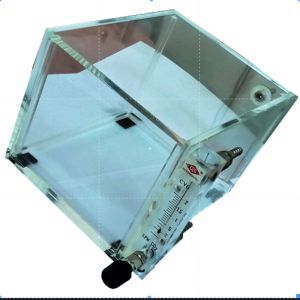 In the euthanasia chamber setup, a CO2 cylinder is connected via tubing to one end (Lower End) of a flow controller, while the other end of the flow controller (Upper End) is connected to the Upper nozzle of the chamber. The chamber is designed to be airtight. When the user initiates CO2 flow using the flow controller, the density of CO2 is being higher than that of oxygen (O2), results in CO2 filling the chamber from the bottom to the top. This directional flow ensures that CO2 is first introduced into the lower portion of the chamber and gradually fills upward. MILTON ENTERPRISES, Nashik 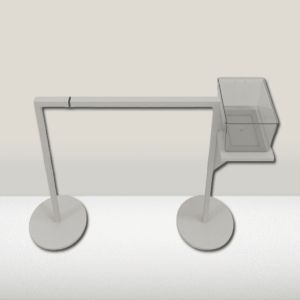 The Narrow Beam Apparatus is a valuable tool in behavioral neuroscience and pharmacology due to its ability to provide precise and quantifiable assessments of motor function. Its applications include:
Drug Development: Screening and evaluating the effects of pharmacological agents on motor coordination and balance.
Neurological Research: Studying the progression and treatment of neurological and neurodegenerative diseases.
Genetic Studies: Understanding the genetic basis of motor function and the impact of genetic modifications.
Toxicology: Assessing the neurotoxic effects of environmental and chemical agents. MILTON ENTERPRISES, Nashik 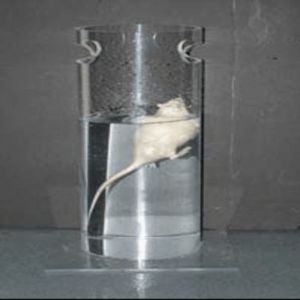 We have proved our expertise in the production of superior quality Forced Swimming Test Apparatus. Our unique manufacturing process results in the production of crystal clear apparatus while at the same time, giving it the toughness to protect it from any accidental damage. They are available in various sizes according to the requirements of our clients. We provide them at competitive market prices with improved quality. All our products are checked before packaging.
Details of Forced Swimming Test Apparatus : It is having Clear and Transparent Water Chamber With Fill & Drain Stop Cocks, made of Non Glossy Acrylic, The forced swim test is a rodent behavioral test used for evaluation of antidepressant drugs, antidepressant efficacy of new compounds, and experimental manipulations that are aimed at rendering or preventing depressive-like states. Mice are placed in an inescapable transparent tank that is filled with water and their escape related mobility behavior is measured. MILTON ENTERPRISES, Nashik 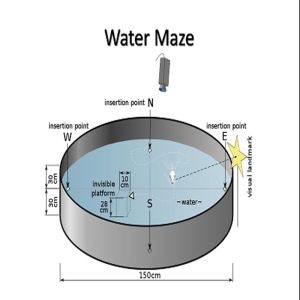 The water maze, often referred to as the Morris Water Maze (MWM), is a widely used experimental apparatus in behavioral neuroscience for assessing spatial learning and memory in rodents, particularly rats and mice. Here are the primary uses and significance of the water maze in research: Primary Uses of the Water Maze Assessment of Spatial Learning and Memory: Spatial Navigation: The MWM is primarily used to study spatial navigation. Rodents must learn to locate a hidden platform submerged just below the water surface using spatial cues around the maze. Reference Memory: The test assesses the rodent's ability to remember the location of the hidden platform over repeated trials and across days, providing a measure of long-term spatial memory.. Improved performance, such as faster learning and quicker location of the platform, suggests the drug's potential as a cognitive enhancer. Cognitive Impairments: The MWM is also used to model cognitive impairments due to factors such as aging, neurodegenerative diseases (e.g., Alzheimer's disease), brain injuries, or genetic modifications. Poor performance indicates deficits in learning and memory. Studying the Effects of Neurotransmitter Systems: The MWM helps investigate the roles of various neurotransmitter systems (e.g., cholinergic, glutamatergic, dopaminergic) in spatial learning and memory. By administering specific receptor agonists or antagonists, researchers can elucidate the involvement of these systems in cognitive processes. Behavioral Phenotyping: The MWM is used for behavioral phenotyping of different rodent strains or genetically modified animals. It provides insights into the genetic and molecular basis of spatial learning and memory. Neurodevelopmental Studies: Researchers use the MWM to study the effects of early-life experiences, environmental factors, and developmental processes on spatial learning and memory. Neuroplasticity and Brain Function: The MWM is valuable for studying neuroplasticity, brain function, and the effects of various interventions (e.g., exercise, enriched environments) on cognitive abilities. Procedure Overview Apparatus Setup: The MWM consists of a large circular pool filled with opaque water to hide a submerged platform. The pool is usually divided into quadrants, with spatial cues placed around the room to aid navigation. Training Sessions: Acquisition Phase: During training, rodents are placed in the pool and allowed to swim and search for the hidden platform. They use distal spatial cues to learn the platform's location over multiple trials. Probe Trials: In probe trials, the platform is removed, and the rodent's search pattern is observed to assess memory retention. Time spent in the target quadrant (where the platform was located) is measured. Testing Sessions: Retention Tests: These tests assess how well the rodent remembers the platform location after a delay period, which can range from hours to days. Reversal Learning: In reversal learning tasks, the platform is moved to a new location, and the rodent's ability to learn the new location is tested, assessing cognitive flexibility. Data Analysis: Key metrics include the latency to find the platform, path length, swim speed, time spent in the target quadrant during probe trials, and search strategies. These measures provide insights into spatial learning, memory, and cognitive flexibility. Significance in Research The Morris Water Maze is a powerful tool in neuroscience and behavioral research due to its ability to provide robust and reliable measures of spatial learning and memory. Its applications span various areas, including: Drug Development: Testing the efficacy of potential treatments for cognitive disorders. MILTON ENTERPRISES, Nashik 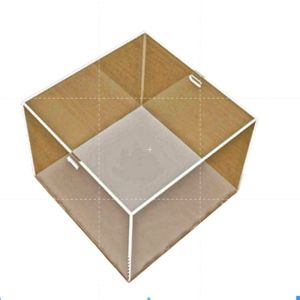 The open field test (OFT) is a widely used behavioral assay in pharmaceutical and neuroscience research to assess locomotion, anxiety, and exploratory behavior in rodents, typically rats and mice. Here are the primary uses and significance of the open field test: Assessment of Locomotor Activity: The OFT is used to measure the overall locomotor activity of rodents. Researchers record the total distance traveled, speed, and movement patterns, providing insights into the animal's general activity levels and motor functions. Evaluation of Anxiety and Exploration: Center vs. Periphery Exploration: The open field arena is usually a large, square or circular area with defined center and peripheral zones. Rodents naturally tend to stay close to the walls (thigmotaxis) due to anxiety and avoid the open center area. The time spent in the center versus the periphery can indicate the level of anxiety. Less anxious animals will spend more time exploring the center. Rearing and Grooming: Additional behaviors such as rearing (standing on hind legs) and grooming are also observed as indicators of exploratory behavior and emotional state. Testing Anxiolytic and Anxiogenic Compounds: The OFT is commonly used to evaluate the effects of pharmacological agents on anxiety. Anxiolytic (anxiety-reducing) drugs typically increase the time spent in the center area and overall exploration, while anxiogenic (anxiety-inducing) substances decrease these behaviors. Assessment of Motor Deficits and Stimulants: The OFT helps in assessing motor coordination and potential side effects of drugs that might affect locomotion. It is also used to evaluate the effects of stimulants, which typically increase locomotor activity. Behavioral Phenotyping: The test is used for behavioral phenotyping of different rodent strains or genetically modified animals. It provides baseline data on activity levels, anxiety, and exploratory behavior, helping to characterize the behavioral phenotype associated with specific genetic modifications. Studying Neurodegenerative and Psychiatric Disorders: The OFT is utilized to model and study various neurological and psychiatric disorders. For example, reduced locomotor activity may indicate neurodegenerative conditions like Parkinson's disease, while altered anxiety-like behaviors can be relevant to models of anxiety or depression. Assessment of Drug Withdrawal and Dependence: The OFT can be used to study the effects of drug withdrawal and dependence. Changes in locomotor activity and anxiety levels after withdrawal from substances like opioids or psychostimulants provide insights into the behavioral consequences of dependence and potential treatments. Longitudinal Studies: The OFT allows for longitudinal studies to track changes in behavior over time. This is useful for studying the progression of diseases, the long-term effects of treatments, or developmental changes in behavior. Procedure Overview Setup: The open field arena is typically an enclosed, square or circular space with clear delineations of center and peripheral zones. Placement of Animal: The rodent is placed in the center or periphery of the arena, depending on the specific experimental design. Observation and Recording: The animal's behavior is recorded using video tracking systems or manually, noting parameters such as time spent in different zones, total distance traveled, and specific behaviors like rearing or grooming. Data Analysis: The collected data is analyzed to determine locomotor activity, anxiety levels, and exploratory behavior. MILTON ENTERPRISES, Nashik .png) The shuttle box, also known as the shuttle avoidance box or active avoidance box, is an apparatus used in behavioral research with rats and mice to study learning, memory, anxiety, and the effects of various pharmacological agents. Here are the primary uses and applications of the shuttle box in pharmaceutical research: Learning and Memory Studies: Active Avoidance Learning: In the shuttle box, rodents learn to avoid an aversive stimulus, such as a mild electric shock, by moving from one compartment to another when a conditioned stimulus (e.g., a light or sound) is presented. The number of successful avoidances and the latency to avoid the shock are measured to assess the animal's learning and memory capabilities. Passive Avoidance Learning: In a variation of the test, the animal learns to avoid entering a compartment where it previously received a shock. This helps in studying memory retention and the effects of drugs on memory consolidation and retrieval. Testing Cognitive Enhancers and Impairments: The shuttle box is used to evaluate the effects of cognitive enhancers, such as nootropic drugs, on learning and memory. Improvements in avoidance behavior suggest enhanced cognitive function. Conversely, it is also used to study cognitive impairments induced by various factors such as aging, neurodegenerative diseases, or drug treatments, providing insights into mechanisms of cognitive decline and potential therapeutic interventions. Anxiety and Stress Research: The shuttle box can be used to assess anxiety and stress responses. The latency to move between compartments and the overall activity can indicate the animal's anxiety levels. Pharmacological agents that reduce anxiety typically decrease the latency and increase exploratory behavior. Pharmacological Testing: Researchers use the shuttle box to test the effects of various pharmacological agents, including anxiolytics, antidepressants, antipsychotics, and cognitive enhancers. By observing changes in avoidance behavior, researchers can infer the efficacy and potential side effects of these drugs. Dose-response studies can be conducted to determine the optimal dosage and efficacy of drugs. Mechanistic Studies: The shuttle box helps in investigating the neurobiological mechanisms underlying learning, memory, anxiety, and stress. By using specific pharmacological agents or genetic manipulations, researchers can study the role of different neurotransmitter systems (e.g., dopamine, serotonin, glutamate) and brain regions in these processes. Behavioral Phenotyping: It is used for behavioral phenotyping of genetically modified rodents. By comparing the performance of wild-type and genetically altered animals in the shuttle box, researchers can identify genes that play a critical role in cognitive and emotional behaviors. Validation of Animal Models: The shuttle box is employed to validate animal models of psychiatric and neurological disorders. Demonstrating that certain genetic or environmental manipulations result in altered avoidance behavior helps establish these models for studying human diseases and testing potential treatments. MILTON ENTERPRISES, Nashik 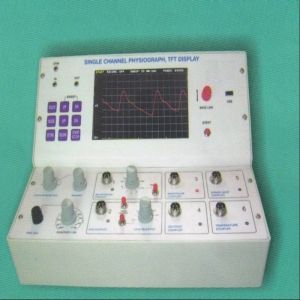 Digital Student Physiograph with High resolution colored TFT Display Student Physiograph is used or the recording of Bio-electrical potentials, E.g. EEG, ECG, ENG, EMG, Pulse, Respiration, Blood pressure ETC, IT is made of light metal for compactness and lightness. Its performance is outstanding due to adoption of integrated circuits.
Features:
1. Indigenous digital physiograph with time and event channel,
2. Compact light weight and easy to operate by a beginner,
3. Standalone unit having coloured TFT display for displaying online & offline recording data,
4. System has six couplers fitted in a single unit easy to carry,
5. System has eight transducers (Force, Pressure, Volume, Respiration, Temperature, Pulse, Respiration Belt, & Isotonic),
6. Facility to store Recording data and review the same on TFT,
7. Interface to the Computer- through USB,
8. System provided with software to review and print the recorded data from PC,
Couplers: To record different parameters the standard range of coupler is as follows,
Bio-potential coupler: for recording all AC phenomena like ECG, EMG, ENG, EEG etc. It is supplied with 3 pin junction box, EEG-EMG electrodes and paste etc.
Straingage coupler: It is used to record muscle activity force, effect of drug on heart activity, blood pressure from cannulated animal, volume changes etc.
Pulse â?? Respiration coupler: It is used to recording pulse or respiratory activity using pulse respiration belt or respiration transducer.
Isotonic coupler: It is used to record isotonic fine movement transducer one can perform experiment on Isolated uterus and Isolated intestine.
EKG coupler: It is used to record clinical ECG. It is supplied with 5 pin junction box, limb & chest electrodes and jelly.
Temperature coupler: It is used to record internal or surface temperature.
Transducers: A transducer is a device which converts one form of physical energy in to electrical energy or vice versa. To record parameters which are not available in electrical form e.g. pulse, respiration, temperature, phono cardiogramme etc., one needs to use appropriate transducer.
Technical Specifications:
No. of channels: 1, 2, & 3.
Display & Size: Coloured TFT- 15.5x9.5 cm.
Channel width: 80 mm.
A/D conversion: 16-bit A/D.
Sensitivity: 50, 100, 200, 500 uv/cm & 0.5, .1, .2, .5, 1, 2, 5, 10, 20, 50, 100 div/ sec.
Data sampling frequency: > 256 Hz.
Notch Filter: 50-60 Hz.
Input Impendence: > 1mega Ohm.
CMRR: > 80-85 db.
Standard Accessories:
ECG electrodes: 1 Set of 4 Nos.
EEG electrodes: 10 Nos.
Bio-potential junction box: 1 No.
EMG disc electrodes: 1 set of 10 Nos.
Ground electrodes: 1 No.
EEG Paste: 1 Jar.
ECG Jelly: 1 Bottle
Operating Manual: 1 No. MILTON ENTERPRISES, Nashik 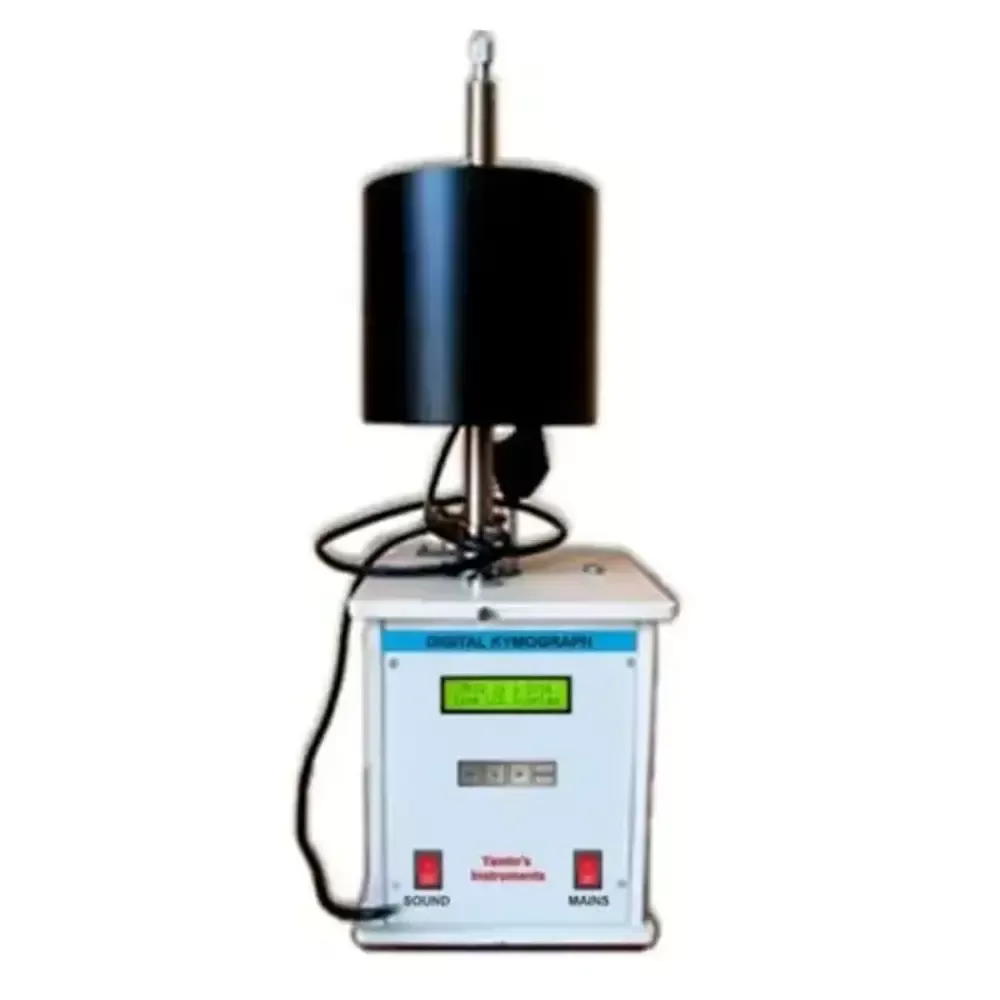 Milton Enterprises introduces digital kymograph having user friendly, gear free, maintenance free operated and controlled on low voltage by microcontroller, user can change base line and drug contact time as their requirement or desired experimental, no needed to stop rotating drum manually it will stop automatically after finished the baseline here user can change / fill ringer solution and just press continue key, rotating drum will continue in mention manner same procedure will continue after drug contact time after giving / injecting drug during experiment in pharmacy colleges, medical colleges, and research institutes. MILTON ENTERPRISES, Nashik 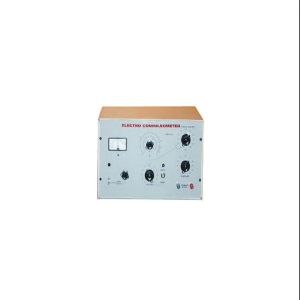 Electroconvulsometer is an instrument used in pharmacology and neuroscience research to induce and measure convulsions (seizures) in animal models. This device is primarily used in the study of epilepsy, seizure thresholds, and the efficacy of anticonvulsant drugs. Key Uses of an Electroconvulsometer: Seizure Induction: The device delivers controlled electrical stimuli to animals, typically rodents, to induce seizures. This is crucial for testing the efficacy of potential anticonvulsant medications. Measurement of Seizure Activity: By recording the onset, duration, and intensity of seizures, researchers can evaluate the pharmacological effects of different substances on seizure activity. Threshold Determination: It helps determine the seizure threshold the minimum electrical stimulus required to induce a seizure. Changes in the seizure threshold can indicate the effectiveness of anticonvulsant treatments. Components of an Electroconvulsometer: Electrodes: Placed on the animal to deliver electrical pulses. Stimulus Controller: Regulates the intensity, duration, and frequency of the electrical stimulus. Recording System: Monitors and records the physiological responses, such as muscle contractions and brain activity. Applications: Anticonvulsant Drug Testing: Evaluating new drugs for their ability to prevent or reduce the severity of seizures. Epilepsy Research: Understanding the mechanisms underlying epileptic seizures and testing potential therapeutic interventions. Neuropharmacology: Studying the effects of various pharmacological agents on brain function and seizure activity. MILTON ENTERPRISES, Nashik 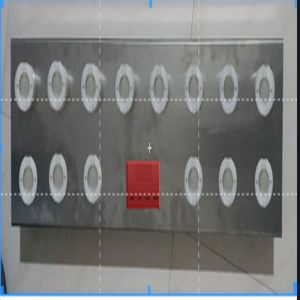 14 stages diffusion cell apparatus having 14 stages means user can place at the same time 14 diffision cell, in addition to 14 stages our apparatus having semi tuto sampling system which gives user friendly sampling without any hectic work, to avoid introduction of air bubbles in the media of receptor cell
close
Post Your Requirement
{{inquiryMessage}}
|